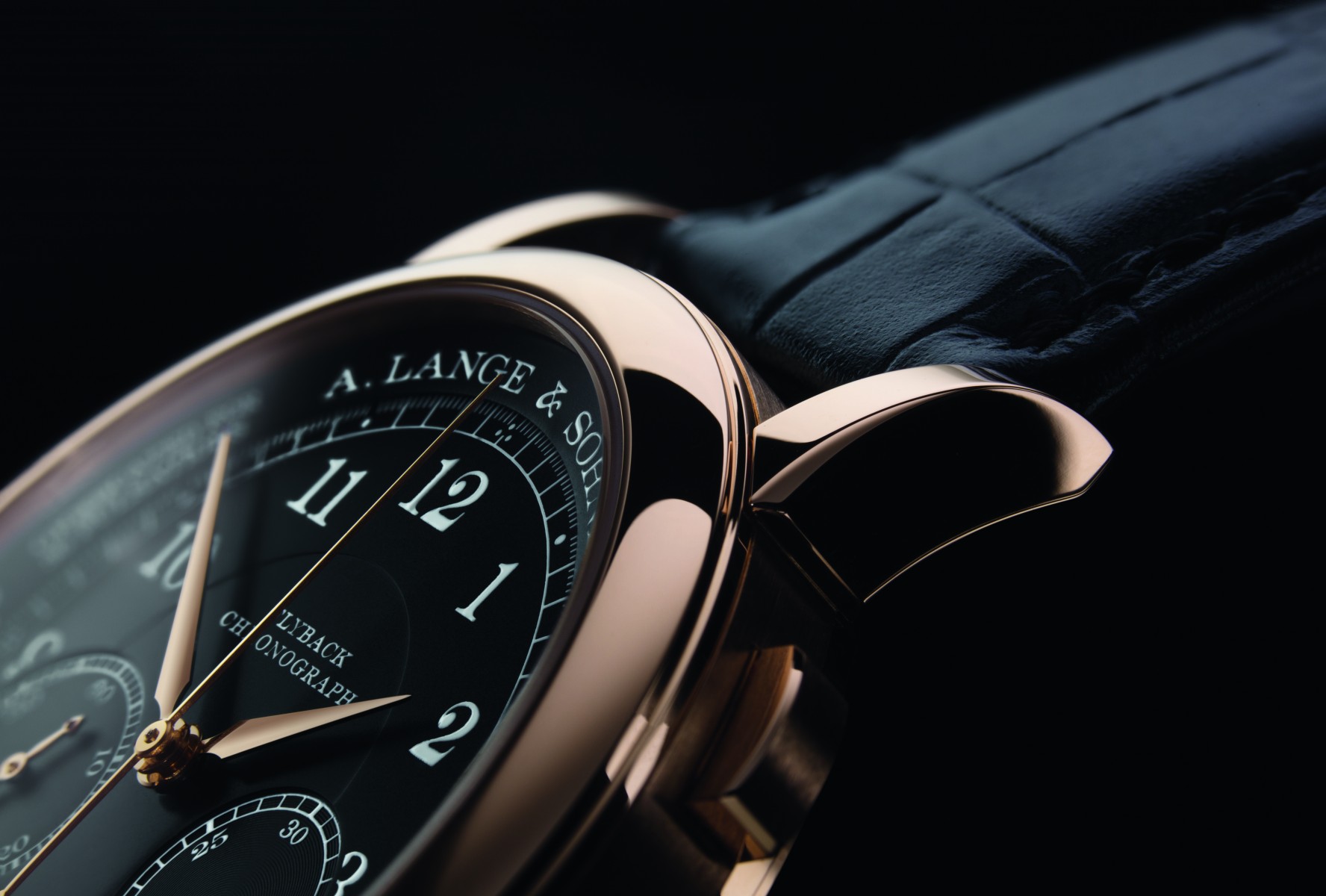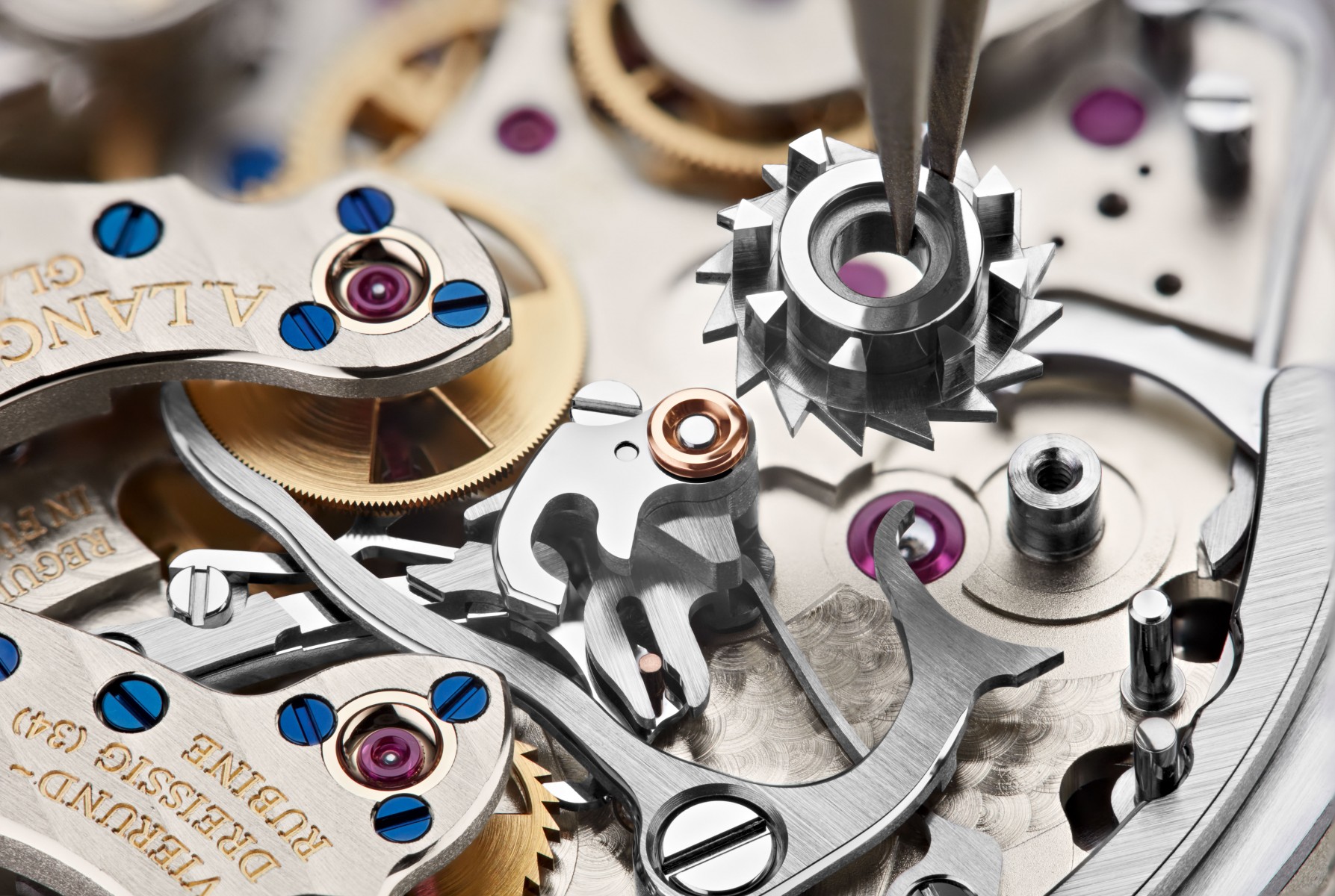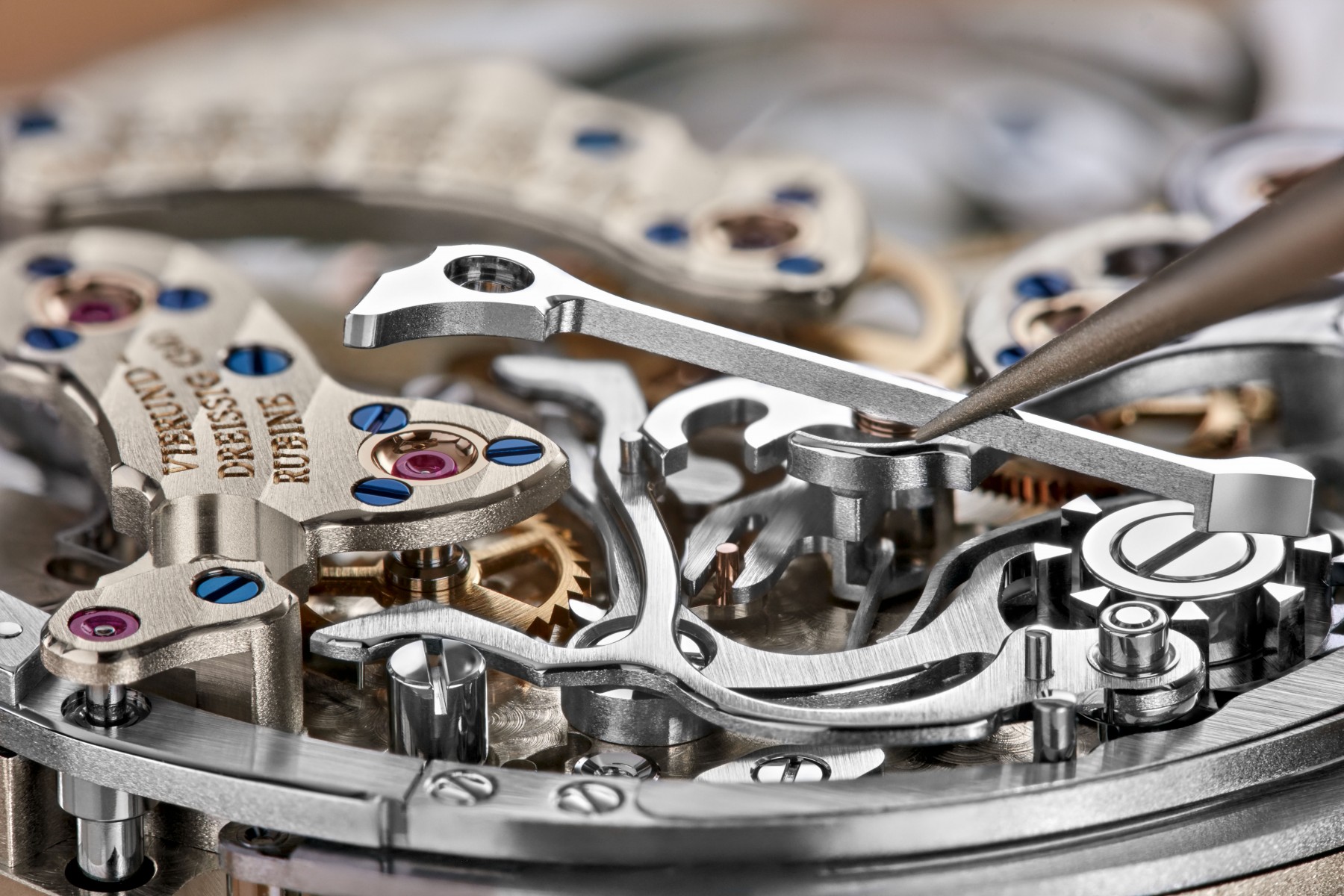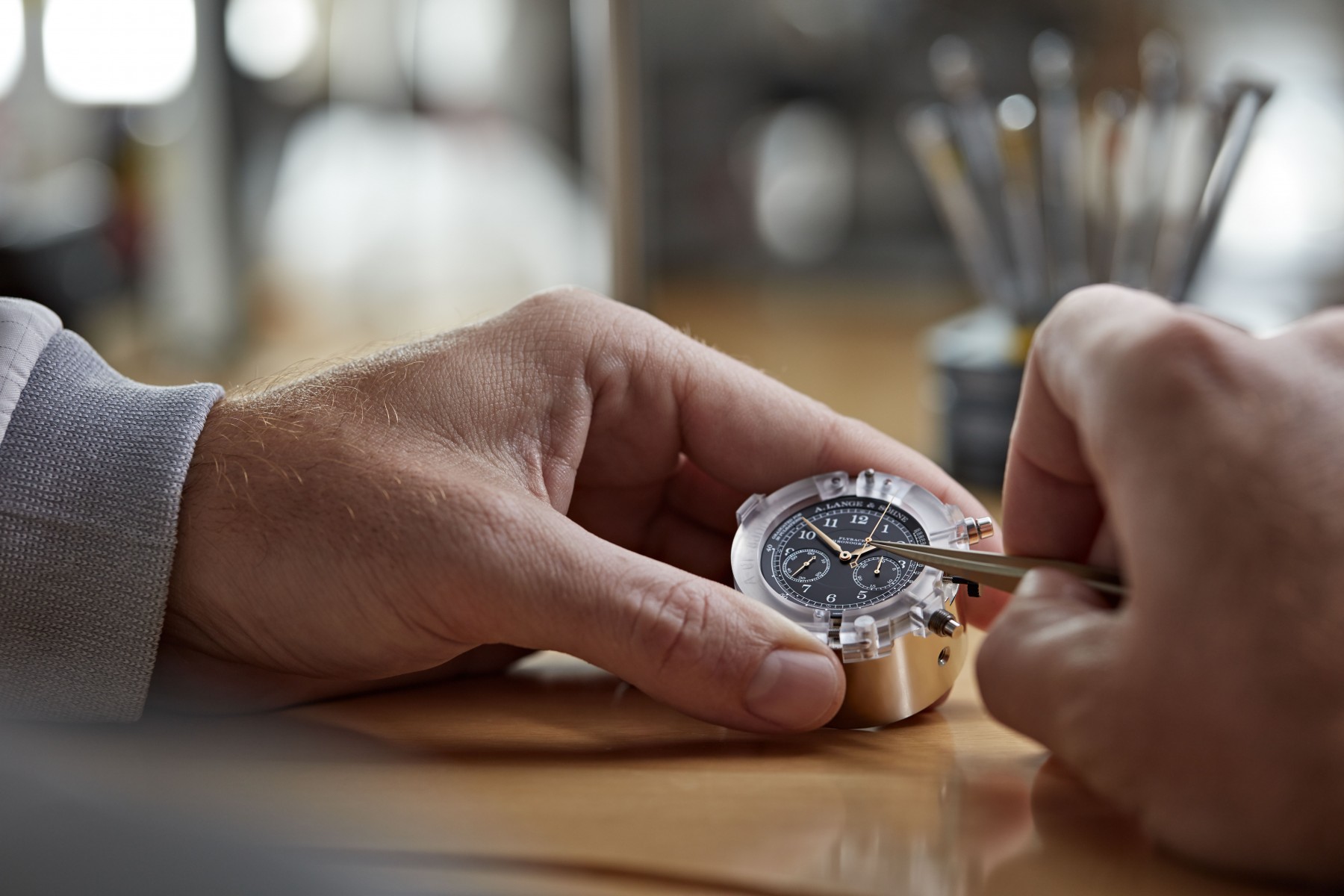Time-lapse in time writing
Insights into the making of the 1815 CHRONOGRAPH
Starting with the production of its 306 parts, nearly nine months elapse before the manufacture calibre L951.5 is completed. Endowed with column-wheel control, the flyback function and the precisely jumping minute counter, the chronograph movement is regarded as a technical and aesthetic masterpiece by connoisseurs. Its assembly calls for the utmost in craftsmanship.
As regards horological complications, the chronograph offers its owner the ultimate level of interaction. While the technical complexity of a perpetual calendar or tourbillon remains concealed, a chronograph is repeatedly started, stopped and reset. The uncompromising ambition of A. Lange & Söhne’s watchmakers is that after many years the switching sequences of their chronographs are executed as dependably and precisely as on the first day.
The 1815 Chronograph has been a cornerstone of the 1815 watch family since 2004. Since the 2018 Salon International de la Haute Horlogerie in Geneva, the timepiece has been available in four versions: white or pink gold with a black or argenté dial. The model enjoys cult status among purists due to its quintessential immaculacy in function and design. Sophisticated technology lies beneath the clearly configured dial. The sapphire-crystal caseback allows the switching sequences to be observed. It exposes the column wheel that controls the stop functions, the flyback mechanism and the minute-counter lever for the precisely jumping minute counter. A patented construction advances the minute-counter hand of the 30-minute totaliser by exactly one graduation every 60 seconds, even if the time measurement happens to be stopped during the zero passage. This guarantees a precise minute-counter reading at all times.
The more complex a mechanism, the more rigorous the requirements imposed on the watchmakers assigned to the assembly process. One of the biggest challenges is building the chronograph mechanism, especially if the movement includes complications such as a flyback function. This is why, at A. Lange & Söhne, a team of seasoned experts is entrusted with this special discipline. One and the same watchmaker is responsible for the first and second assembly sequences, as is typically practised at Lange.
Assembly of the column wheel
In the mid 1990s, when A. Lange & Söhne began to develop a proprietary chronograph calibre, it did not take long to decide in favour of a classic column-wheel-control concept. Initially introduced in the 19th century, the use of a column wheel for executing the start, stop and reset functions is considered to be a manifestation of traditional watchmaking artistry. The complex eight-column wheel in the 1815 Chronograph requires top-tier craftsmanship as well as true virtuosity in the assembly phase.
Assembly of the flyback lever
The flyback function is one of the technical highlights of the L951.5 manufacture calibre. Originating from the early days of aviation, this mechanism makes it possible to perform instantly consecutive time measurements by combining three steps – stop, reset and restart – into one. Pressing the chronograph button at 4 o’clock stops an ongoing measurement instantaneously and causes the chronograph sweep-seconds hand to jump to the zero position at 12 o’clock. A new measurement begins as soon as the button is released. The biggest challenge in the assembly of the flyback lever involves the accurate adjustment of the clearly discernible pressure point.
Assembly of the chronograph wheel and the heart cam
The longest arbor in the movement connects the chronograph wheel at the bottom to the chronograph sweep-seconds hand. Firmly secured to the wheel, the heart cam returns the chronograph sweep-seconds hand to zero at the end of a measurement. When the contact surface of the heart lever presses against the heart cam, this instantaneously brings it back to the home position together with the chronograph sweep-seconds hand.
Assembly of the heart-lever spring
The heart-lever spring keeps the heart lever tensioned. Like all other components, this part is lavishly finished by hand before being delivered to the watchmaker’s table for chronograph assembly. To minimise friction, the interacting surfaces are painstakingly flat-polished. There, not even the smallest scratch is tolerated after the assembly process is completed. The peripheral chamfer is polished, the circumference grained and the top side decorated with a flat polish.
Assembly of the clutch rocker
Of the 306 parts of the L951.5 manufacture calibre, no fewer than 13 constitute the clutch rocker. It plays an essential role in starting and stopping a time measurement. When the button at 2 o’clock is pressed, the column wheel is advanced by one step. The clutch rocker falls into one of the gaps between the eight columns and then pivots the chrono clutch wheel towards the middle of the movement. The flow of power between the going train and the chronograph mechanism is established, and the chronograph sweep-seconds hand begins to run. The shape of the complex steel part is as elaborate as it is artisanally perfect: The peripheral chamfers and the acute re-entrant angles are always polished by hand, while the surface is straight-grained and integrates a mirror-polished gold chaton secured with three thermally blued screws.
Technical polishes and adjustments
Although all movement parts are crafted with manufacturing tolerances in the range of thousandths of a millimetre at A. Lange & Söhne, the chronograph assembly process requires the watchmaker to execute a series of individual adjustments until everything is perfectly harmonised. This also applies to the clutch rocker whose interacting surfaces are beautifully polished, which also keeps friction losses to a minimum.
Assembly of the oscillator
Developed and crafted by A. Lange & Söhne, the large balance wheel with its six precisely adjustable eccentric poising weights delivers outstanding rate accuracy. Turning the small weights shifts their centres of gravity and changes the rate of the watch. The freely oscillating balance spring, also made in-house, powers the balance. It is precisely paired with the characteristics of the movement and beats with a frequency of 18,000 semi-oscillations per hour. The watchmaker adds the escapement at the very end once the chronograph mechanism has already been integrated. He must therefore position it in the movement with extreme care.
Adjustments and button test under the microscope
After the second assembly pass, the watchmaker again performs a full check-up of the movement. This requires using a microscope to verify the mesh of all levers and wheels – for instance, between the clutch and the chronograph wheel – and making final adjustments. Additionally, the watchmaker tests all the switching processes to guarantee functional reliability and to ensure that the future owner will derive long-lasting pleasure from the watch.
Assembly of dial and hands
The watchmaker secures the five hands to their respective arbors shortly before the finished L951.5 chronograph calibre is placed inside its white- or pink-gold case. The filigreed chronograph sweep-seconds hand is the last of the hands to be mounted. Depending on the case material, it is made of either gold-plated or blued steel. Precisely aligning the extremely thin and long hand with the hour marker at 12 o’clock is a particularly challenging task.












